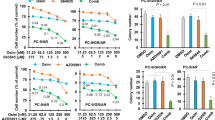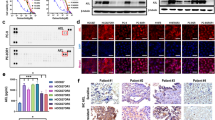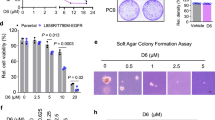Abstract
EGFR tyrosine kinase inhibitors (TKIs) are standard therapy for EGFR-mutant non-small cell lung cancer (NSCLC); however, these tumours eventually acquire chemoresistance. U3-1402 is an anti-HER3 antibody–drug conjugate with a novel topoisomerase I inhibitor, DXd. In the current study, we evaluated the anticancer efficacy of U3-1402 in EGFR-mutant NSCLC cells with acquired resistance to EGFR-TKIs. HCC827GR5 and PC9AZDR7 are EGFR-TKI-resistant clones for gefitinib and osimertinib, respectively. U3-1402 alone or in combination with the EGFR-TKI erlotinib demonstrated potent anticancer efficacy in HCC827GR5 cells using an in vitro growth inhibition assay and in vivo xenograft mouse model. U3-1402 induced apoptosis in HCC827GR5 cells accompanying phosphorylation of histone H2A.X, a marker of DNA damage, but did not block HER3/PI3K/AKT signalling. Further, we found using flow cytometry that the cell surface HER3 expression level in HCC827GR5 cells was twice that found in HCC827 cells, indicating internalization of U3-1402 was increased in resistant cells. In addition, administration of U3-1402 notably repressed growth of EGFR-TKI osimertinib-resistant PC9AZDR7 xenograft tumours, and that PC9AZDR7 cells expressed five times greater cell surface HER3 than PC9 cells. Furthermore, using immunofluorescent microscopy, HER3 was observed predominantly in the nucleus of PC9 cells, but was localized in the cytoplasm of PC9AZDR7 cells. This finding indicates that altered trafficking of the HER3-U3-1402 complex may accelerate linker payload cleavage by cytoplasmic lysosomal enzymes, resulting in DNA damage. Our results indicate that administration of U3-1402 alone or in combination with an EGFR-TKI may have potential as a novel therapy for EGFR-TKI-resistant EGFR-mutant NSCLC.
This is a preview of subscription content, access via your institution
Access options
Subscribe to this journal
Receive 50 print issues and online access
$259.00 per year
only $5.18 per issue
Buy this article
- Purchase on Springer Link
- Instant access to full article PDF
Prices may be subject to local taxes which are calculated during checkout





Similar content being viewed by others
References
Campbell MR, Amin D, Moasser MM. HER3 comes of age: new insights into its functions and role in signalling, tumour biology, and cancer therapy. Clin Cancer Res. 2010;16:1373–83.
Yi ES, Harclerode D, Gondo M, Stephenson M, Brown RW, Younes M, et al. High c-erbB-3 protein expression is associated with shorter survival in advanced non-small cell lung carcinomas. Mod Pathol. 1997;10:142–8.
Cappuzzo F, Toschi L, Domenichini I, Bartolini S, Ceresoli GL, Rossi E, et al. HER3 genomic gain and sensitivity to gefitinib in advanced non-small-cell lung cancer patients. Br J Cancer. 2005;93:1334–40.
Engelman JA, Jänne PA, Mermel C, Pearlberg J, Mukohara T, Fleet C, et al. ErbB-3 mediates phosphoinositide 3-kinase activity in gefitinib-sensitive non-small cell lung cancer cell lines. Proc Natl Acad Sci USA. 2005;102:3788–93.
Engelman JA, Zejnullahu K, Mitsudomi T, Song Y, Hyland C, Park JO, et al. MET amplification leads to gefitinib resistance in lung cancer by activating ERBB3 signalling. Science. 2007;316:1039–43.
Yonesaka K, Hirotani K, Kawakami H, Takeda M, Kaneda H, Sakai K, et al. Anti-HER3 monoclonal antibody patritumab sensitizes refractory non-small cell lung cancer to the epidermal growth factor receptor inhibitor erlotinib. Oncogene. 2016;35:878–86.
Sergina NV, Rausch M, Wang D, Blair J, Hann B, Shokat KM, et al. Escape from HER-family tyrosine kinase inhibitor therapy by the kinase-inactive HER3. Nature. 2007;445:437–41.
Mendell J, Freeman DJ, Feng W, Hettmann T, Schneider M, Blum S, et al. Clinical translation and validation of a predictive biomarker for patritumab, an anti-human epidermal growth factor receptor 3 (HER3) monoclonal antibody, in patients with advanced non-small cell lung cancer. EBioMedicine. 2015;2:264–71.
Meulendijks D, Jacob W, Voest EE, Mau-Sorensen M, Martinez-Garcia M, Taus A, et al. Phase Ib study of lumretuzumab plus cetuximab or erlotinib in solid tumour patients and evaluation of HER3 and heregulin as potential biomarkers of clinical activity. Clin Cancer Res. 2017. https://doi.org/10.1158/1078-0432.CCR-17-0812.
Juric D, Dienstmann R, Cervantes A, Hidalgo M, Messersmith W, Blumenschein GR, et al. Safety and pharmacokinetics/pharmacodynamics of the first-in-class dual action HER3/EGFR antibody MEHD7945A in locally advanced or metastatic epithelial tumours. Clin Cancer Res. 2015;21:2462–70.
Shimizu T, Yonesaka K, Hayashi H, Iwasa T, Haratani K, Yamada H, et al. Phase 1 study of new formulation of patritumab (U3-1287) Process 2, a fully human anti-HER3 monoclonal antibody in combination with erlotinib in Japanese patients with advanced non-small cell lung cancer. Cancer Chemother Pharmacol. 2017;79:489–95.
Ueno S, Hirotani K, Abraham R, Blum S, Frankenberger B, Redondo-Muller M, et al. U3-1402, a novel HER3-targeting ADC with a novel DNA topoisomerase I inhibitor, demonstrates a potent anti-tumour efficacy. Cancer Res. 2017;77(Suppl 13):3092. https://doi.org/10.1158/1538-7445.AM2017-3092.
Ogitani Y, Aida T, Hagihara K, Yamaguchi J, Ishii C, Harada N, et al. DS-8201a, a novel HER2-targeting ADC with a novel DNA topoisomerase I inhibitor, demonstrates a promising antitumor efficacy with differentiation from T-DM1. Clin Cancer Res. 2016;22:5097–108.
Takegawa N, Nonagase Y, Yonesaka K, Sakai K, Maenishi O, Ogitani Y, et al. DS-8201a, a new HER2-targeting antibody-drug conjugate incorporating a novel DNA topoisomerase I inhibitor, overcomes HER2-positive gastric cancer T-DM1 resistance. Int J Cancer. 2017. https://doi.org/10.1002/ijc.30870.
Zhou C, Yao LD. Strategies to improve outcomes of patients with EGFR-mutant non-small cell lung cancer: review of the literature. J Thorac Oncol. 2016;11:174–86.
Kobayashi S, Boggon T, Dayaram T, Jänne PA, Kocher O, Meyerson M, et al. EGFR mutation and resistance of non-small cell lung cancer to gefitinib. N Engl J Med. 2005;352:786–92.
Jänne PA, Yang JCH, Kim DW, Planchard D, Ohe Y, Ramalingam SS, et al. AZD9291 in EGFR inhibitor-resistant non-small-cell lung cancer. N Engl J Med. 2015;372:1689–99.
Yonesaka K, Zejnullahu K, Okamoto I, Satoh T, Cappuzzo F, Souglakos J, et al. Activation of ERBB2 signalling causes resistance to the EGFR-directed therapeutic antibody cetuximab. Sci Transl Med. 2011;3:99ra86.
Reif R, Adawy A, Vartak N, Schröder J, Günther G, Ghallab A, et al. Activated ErbB3 translocates to the nucleus via clathrin-independent endocytosis, which is associated with proliferating cells. J Biol Chem. 2016;291:3837–47.
Offterdinger M, Schöfer C, Weipoltshammer K, Grunt TW. c-erbB-3: a nuclear protein in mammary epithelial cells. J Cell Biol. 2002;157:929–39.
Begnami MD, Fukuda E, Fregnani JH, Nonogaki S, Montagnini AL, da Costa WL, et al. Prognostic implications of altered human epidermal growth factor receptors (HERs) in gastric carcinomas: HER2 and HER3 are predictors of poor outcome. J Clin Oncol. 2011;29:3030–6.
Trocme E, Mougiakakos D, Johansson CC, All-Eriksson C, Economou MA, Larsson O, et al. Nuclear HER3 is associated with favorable overall survival in uveal melanoma. Int J Cancer. 2012;130:1120–7.
Sequist LV, Waltman BA, Dias-Santagata D, Digumarthy S, Turke AB, Fidias P. et al. Genotypic and histological evolution of lung cancers acquiring resistance to EGFR inhibitors. Sci Transl Med. 2011;3:75ra26
Jia Y, Yun CH, Park E, Ercan D, Manuia M, Juarez J, et al. Overcoming EGFR(T790M) and EGFR(C797S) resistance with mutant-selective allosteric inhibitors. Nature. 2016;534:129–32.
Takezawa K, Pirazzoli V, Arcila ME, Nebhan CA, Song X, de Stanchina E, et al. HER2 amplification: a potential mechanism of acquired resistance to EGFR inhibition in EGFR-mutant lung cancers that lack the second-site EGFRT790M mutation. Cancer Discov. 2012;2:922–33.
Loganzo F, Sung M, Gerber HP. Mechanisms of resistance to antibody-drug conjugates. Mol Cancer Ther. 2016;15:2825–34.
Doi T, Iwata H, Tsurutani J, Takahashi S, Park H, Redfern CH, et al. Single agent activity of DS-8201a, a HER2-targeting antibody-drug conjugate, in heavily pretreated HER2 expressing solid tumours. J Clin Oncol. 2017;35(Suppl 15):108. https://doi.org/10.1200/JCO.2017.35.15_suppl.108
Burris HA 3rd, Rugo HS, Vukelja SJ, Vogel CL, Borson RA, Limentani S, et al. Phase II study of the antibody drug conjugate trastuzumab-DM1 for the treatment of human epidermal growth factor receptor 2 (HER2)-positive breast cancer after prior HER2-directed therapy. J Clin Oncol. 2011;29:398–405.
Chen R, Hou J, Newman E, Kim Y, Donohue C, Liu X, et al. CD30 downregulation, MMAE resistance, and MDR1 upregulation are all associated with resistance to brentuximab vedotin. Mol Cancer Ther. 2015;14:1376–84.
Loganzo F, Tan X, Sung M, Jin G, Myers JS, Melamud E, et al. Tumor cells chronically treated with a trastuzumab-maytansinoid antibody-drug conjugate develop varied resistance mechanisms but respond to alternate treatments. Mol Cancer Ther. 2015;14:952–63.
Acknowledgements
We thank Haruka Yamaguchi, Yume Shinkai, and Michiko Kitano for technical support.
Author information
Authors and Affiliations
Corresponding author
Ethics declarations
Conflict of interest
Dr. Yonesaka and Dr. Nakagawa received research funding from Daiichi Sankyo Co., Ltd., and Dr. Maeda, Dr. Kagari, and Dr. Hirotani are employees of Daiichi Sankyo Co., Ltd. The remaining authors declare that they have no conflict of interest.
Financial support
This study was financially supported by Daiichi Sankyo Co., Ltd. U3-1402 and patritumab were provided by Daiichi Sankyo Co., Ltd.
Rights and permissions
About this article
Cite this article
Yonesaka, K., Takegawa, N., Watanabe, S. et al. An HER3-targeting antibody–drug conjugate incorporating a DNA topoisomerase I inhibitor U3-1402 conquers EGFR tyrosine kinase inhibitor-resistant NSCLC. Oncogene 38, 1398–1409 (2019). https://doi.org/10.1038/s41388-018-0517-4
Received:
Revised:
Accepted:
Published:
Issue Date:
DOI: https://doi.org/10.1038/s41388-018-0517-4
This article is cited by
-
Drug conjugates for the treatment of lung cancer: from drug discovery to clinical practice
Experimental Hematology & Oncology (2024)
-
Changes in HER3 expression profiles between primary and recurrent gynecological cancers
Cancer Cell International (2023)
-
HER3 in cancer: from the bench to the bedside
Journal of Experimental & Clinical Cancer Research (2022)
-
Osimertinib and anti-HER3 combination therapy engages immune dependent tumor toxicity via STING activation in trans
Cell Death & Disease (2022)
-
Unlocking the potential of antibody–drug conjugates for cancer therapy
Nature Reviews Clinical Oncology (2021)



